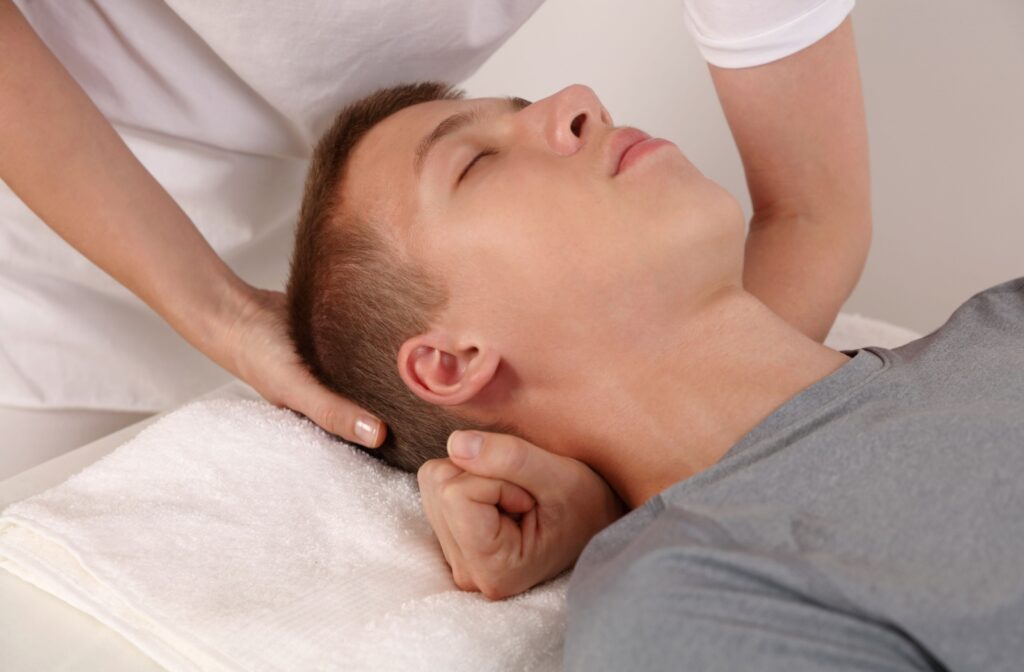Tension and discomfort in the head, neck, and back can significantly impact your quality of life. Craniosacral therapy (CST) CST is becoming increasingly popular as a therapeutic option for those seeking relief from this all too common pain.
It targets the craniosacral system, which consists of the membranes and cerebrospinal fluid surrounding the head and spinal cord. Craniosacral therapy uses gentle, hands-on methods to restore mobility and release tension. The therapy is rooted in the belief that small changes in the craniosacral system can have a ripple effect, improving overall physical and emotional health.
What Causes Tension in the Head, Neck, & Back?
The head, neck, and back are some of the most tension-prone areas of the body. Several factors contribute to this discomfort, including:
- Stress: High levels of stress often manifest as physical tension in these areas. Tight muscles, clenched jaws, and stiff necks are common symptoms of accumulated stress.
- Poor posture: Modern lifestyles encourage prolonged sitting, often in positions that strain the neck, shoulders, and lower back. Over time, this can lead to misalignments and chronic discomfort.
- Physical injuries: Accidents, falls, and traumas, even those that seem minor at the time, can leave lasting imbalances in the body that contribute to persistent tension and pain.
When left unaddressed, these factors can lead to more significant issues, including tension headaches, migraines, stiffness, and even emotional stress. That’s where CST comes in.
How Craniosacral Therapy Relieves Tension
Craniosacral therapy works by facilitating the body’s natural ability to restore balance by focusing on the tightness around the head bones and spinal column down to the sacrum (a bone in the lower back). CST employs minimal pressure, often no more than the weight of a nickel, to encourage subtle but meaningful adjustments in the body. Here’s how it helps address tension:
Gentle Techniques
Practitioners use light touch to assess the craniosacral rhythm and identify restrictions or disruptions in the craniosacral system. This delicate approach can mean minimal discomfort for the client.
Releasing Restrictions
Once identified, practitioners use specific techniques to release tightness. These releases can improve cerebral fluid flow, which may alleviate physical tension and discomfort in the head, neck, and back.
Systemic Benefits
By addressing the craniosacral system, CST indirectly supports other areas of the body. A release in one area may lead to improved posture, reduced stress, and a sense of overall physical and emotional balance.
Benefits of Craniosacral Therapy for Tension Relief
CST offers a wide variety of physical and emotional benefits for those looking to relieve tension. Here are some of the key advantages:
- Improved range of motion: CST can alleviate restrictions, allowing for greater flexibility and mobility in the head, neck, and back.
- Decreased pain and discomfort: Many people report reduced tension headaches, neck stiffness, and back pain after continued sessions.
- Reduced stress and anxiety: The therapeutic techniques promote relaxation, which calms the nervous system and helps reduce stress levels.

What to Expect During a CST Session
Craniosacral therapy sessions are designed to provide a safe, nurturing, and calming environment where healing can unfold naturally. It’s similar to massage therapy, though typically you’ll remain clothed. Sessions take place in a quiet, comfortable room where you can lie on a treatment table.
The therapist uses soft, intentional hand placements around the head, neck, and back to identify areas of tension or imbalance in the craniosacral system. The touch is light and non-invasive, focusing on supporting the body’s natural healing processes.
Your practitioner may guide you to tune into any sensations you feel during the session while ensuring you remain at ease. They’re there to answer any questions or address discomfort if it arises.
Every CST session is unique, as it is influenced by your body’s specific needs and rhythms at the time of treatment. A session can take between 30 minutes to an hour. The goal is always to foster balance and support the body’s natural healing abilities in a gentle yet effective way.
Who Can Benefit from Craniosacral Therapy?
Craniosacral Therapy is versatile, making it suitable for a wide range of people. CST may benefit people with:
- Chronic neck or back pain
- Tension headaches or migraines
- Stress
- Constipation
- TMJ
- Sinus infections
- Scoliosis
Your Next Step to Wellness
It’s never too soon to take the first step toward relieving tension and improving your well-being. Craniosacral therapy offers a gentle path to better relaxation through body alignment. Whether you’re dealing with pain, stress, or simply looking to prioritize your health, CST has the potential to make a meaningful difference.
At Recovery Lab, we’re passionate about providing therapies tailored to your unique needs. You’re more than your pain, so our compassionate, skilled practitioners are here to support you on your wellness journey. Booking an appointment is simple, and we’re ready to help you feel at ease in your body again.
Don’t delay relief. Call us or book online today to discover how we can help you find balance, comfort, and relaxation like never before.



